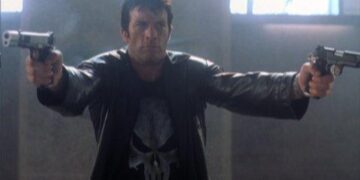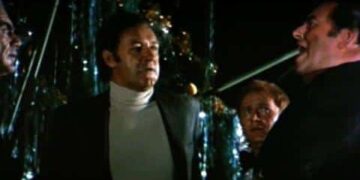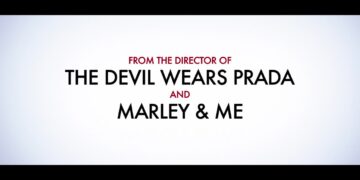When it comes to fashion inspiration, the past is a goldmine, and I’ve struck rich with the 1990 blockbuster,Dick Tracy.
Directed by and starring Warren Beatty, this film is not just a visual feast for its storyline, but it’s a sartorial smorgasbord. The movie, set in the 1930s, is a kaleidoscope of vibrant colors and exaggerated styles that mirror the original comic strip’s aesthetics. It’s a world where fashion isn’t just an afterthought—it’s a character itself.
In this blog post, I’ll take you through a comprehensive character analysis and style breakdown of the film’s most iconic looks. We’ll delve into the movie magic that brings Dick Tracy to life, with an eye on the fashion that sets the tone of the era. So, grab your fedoras and trench coats, because we’re heading back to the time of gangsters, molls, and detectives.
To say I’m excited is an understatement. Dick Tracy is a masterclass in stylized storytelling, where each character’s wardrobe plays a leading role. From the titular character’s iconic yellow coat to the flamboyant villains, each outfit is meticulously crafted to tell us who they are without a single line of dialogue. It’s time to dissect these looks and learn how they can influence modern fashion.
Brief Character Analysis and Style Breakdown
Before we dive into the nitty-gritty of the Dick Tracy wardrobe, let’s set the stage with a brief overview of the characters and their respective styles. The film’s protagonist, Dick Tracy, is the epitome of a 1930s detective, with his sharp suits and trademark yellow trench coat. His look is clean, classic, and instantly recognizable—a testament to the timeless appeal of well-tailored menswear.
Character Style Breakdown:
- Dick Tracy (Warren Beatty): Yellow trench coat, fedora, and bold primary colors.
- Kid (Charlie Korsmo): Newsboy caps, tweed jackets, and a plucky attitude.
- McGillicuddy (Michael Donovan O’Donnell): Understated police attire with a touch of class.
- Stooge (Jim Wilkey): Rugged and worn-in clothing that tells a story of loyalty and roughness.
- Shoulders (Stig Eldred): Bulky silhouette, heavy fabrics, and an imposing presence.
- The Rodent (Neil Summers): Sleek, dark, and somewhat greasy, befitting his character’s name.
- The Brow (Chuck Hicks): Imposing and menacing, with a strong, structured look.
Each character’s style is a direct reflection of their personality and role in the film. The villains, with their grotesque makeup and flamboyant costumes, contrast sharply with Dick Tracy’s more subdued and morally upright appearance. This attention to detail in costuming is what makes Dick Tracy a fascinating case study for both film buffs and fashion enthusiasts.
A Closer Look at the ‘Dick Tracy (1990)’ Aesthetic
The Dick Tracy aesthetic is a hyper-real interpretation of the 1930s. The film’s production design and costumes amplify the era’s fashion to create a world that’s both familiar and otherworldly. The use of color is particularly notable; it’s not just a stylistic choice but a narrative device. Each hue is selected to evoke an emotional response and to signify character alignment—heroes in bright, solid colors and villains in a mix of patterns and textures.
The set and costumes were designed to be as faithful as possible to Chester Gould’s original comic strip, which began in the 1930s. This means that the clothes not only had to look good, but they also had to reflect the exaggerated and stylized nature of the source material. The result is a film that serves as a time capsule of sorts—not of the actual 1930s, but of its graphic representation in one of America’s most iconic comic strips.
To understand the Dick Tracy aesthetic, one must appreciate the artistry behind the wardrobe choices. The film’s costume designer, Milena Canonero, who has multiple Academy Awards to her name, approached each outfit as a standalone piece of art. The wardrobe is a masterful blend of historical accuracy and heightened theatricality, which is precisely what makes the film’s style so captivating and ripe for analysis.
Warren Beatty as Dick Tracy
Now, let’s get down to brass tacks and talk about how to dress like the man himself, Dick Tracy. Warren Beatty’s portrayal is not just a performance—it’s a sartorial statement. The key elements of his outfit are as iconic as the character’s square jaw.
Key Outfit Elements:
- The Yellow Trench Coat: It’s the pií¨ce de résistance of Tracy’s ensemble. The coat’s vibrant color and wide lapels are a visual shorthand for the character’s boldness and righteousness.
- The Fedora: A 1930s detective staple, the fedora is as much a part of Tracy’s identity as his badge. It’s sharp, it’s sleek, and it means business.
- The Suit: Beneath the coat lies a tailored suit, usually in a rich blue or grey, which speaks to Tracy’s professionalism and no-nonsense demeanor.
- The Tie: Tracy’s ties are always in a solid color, complementing his suit and adding to the orderly aesthetic of his appearance.
- The Watch: An often-overlooked detail is Tracy’s wristwatch. It’s classic, functional, and represents his punctuality and attention to detail.
To embody Tracy’s look, one must understand that it’s not just about the clothes—it’s about the attitude. The confidence with which Beatty carries these key pieces is integral to the character. Dressing like Dick Tracy is as much about adopting a certain poise and integrity as it is about the physical wardrobe.
Charlie Korsmo as Kid
Charlie Korsmo’s character, Kid, is the street-smart orphan taken under Tracy’s wing. His style is a mishmash of hand-me-downs and thrift, which is both practical and endearing. The Kid’s clothing is rugged and lived-in, reflecting his tough life on the streets before meeting Tracy.
Key Outfit Elements for Kid:
- The Newsboy Cap: A staple of working-class attire in the 1930s, the cap is symbolic of the Kid’s origins and his scrappy nature.
- The Tweed Jacket: Often oversized, as if borrowed from a life he’s yet to grow into, the tweed jacket is both protective and symbolic of the Kid’s desire for a better life.
- The Knickerbockers: These short trousers, paired with high socks, are a nod to the period and to the Kid’s youthful energy and naivety.
The beauty of the Kid’s style lies in its authenticity. There’s a genuineness to Korsmo’s portrayal, reflected in the way he wears his clothes. They’re not just costumes; they’re part of his character’s story.
Michael Donovan O’Donnell as McGillicuddy
Detective McGillicuddy, played by Michael Donovan O’Donnell, might not have the flash of Tracy or the flamboyance of the villains, but his style is significant nonetheless. It represents the everyman of the era, the hardworking cop on the beat.
Key Outfit Elements for McGillicuddy:
- The Police Uniform: His uniform is standard but well-kept, showing his respect for the job and his dedication to law and order.
- The Badge: Shiny and always visible, it’s a symbol of authority and McGillicuddy’s commitment to justice.
- The Hat: Less stylized than Tracy’s fedora, it’s functional and straightforward, much like the character himself.
McGillicuddy’s style guide is less about fashion and more about function. His wardrobe is designed to be practical and durable, mirroring his role in the film as a reliable and steadfast officer.
Jim Wilkey as Stooge
Jim Wilkey’s Stooge is a henchman with a look that’s as rough around the edges as his character. His style can be described as ‘shabby gangster chic,’ a blend of intimidation and practicality.
Key Outfit Elements for Stooge:
- The Leather Jacket: It’s tough, it’s gritty, and it has seen better days, much like Stooge himself.
- The Slacks: Often dirty and wrinkled, they tell a story of long nights spent doing the dirty work for the film’s villains.
- The Boots: Sturdy and worn, they are ready for action and underscore Stooge’s readiness to jump into a fray.
Stooge’s style is all about survival. It’s functional, with a touch of menace, and it speaks volumes about his role as an enforcer in the criminal underworld of Dick Tracy‘s universe.
Stig Eldred as Shoulders
Shoulders, portrayed by Stig Eldred, is a villain whose name says it all. His wardrobe is designed to accentuate his imposing frame and his role as a muscleman.
Key Outfit Elements for Shoulders:
- The Overcoat: Heavy and broad-shouldered, it amplifies his physical presence and adds to his intimidating silhouette.
- The Fedora: Worn low over the eyes, it adds an element of mystery and danger to his character.
- The Striped Suit: It’s tailored but in a way that suggests power and brute force rather than refinement.
Shoulders’ fashion breakdown is a study in how clothing can be used to enhance a character’s physical attributes and to communicate their role within the story’s hierarchy.
Neil Summers as The Rodent
Neil Summers’ The Rodent is a character whose name and appearance are inextricably linked. His style is slick, somewhat greasy, and exudes a sense of sleaze.
Key Outfit Elements for The Rodent:
- The Suit: Dark and slightly too tight, it’s reminiscent of someone trying to climb the social ladder but not quite comfortable there.
- The Tie: Often askew, it reflects The Rodent’s disheveled nature and underhanded character.
- The Hat: Smaller and less pronounced than other characters’, it’s as if The Rodent is trying to hide in plain sight.
The Rodent’s outfit analysis reveals a character that is both unctuous and untrustworthy, with his wardrobe serving as a visual cue for his sneaky and conniving ways.
Chuck Hicks as The Brow
Chuck Hicks’ The Brow is a villain whose fearsome appearance is matched by his equally daunting wardrobe. His style is all about intimidation and leaving a lasting impression.
Key Outfit Elements for The Brow:
- The Double-Breasted Suit: It’s structured and strong, reinforcing The Brow’s role as a formidable opponent.
- The Wide-Brimmed Hat: Overshadowing his face, it adds to his menacing presence and air of authority.
- The Tie: Invariably a darker shade, it complements his sinister persona and completes the look of a classic gangster.
The Brow’s style inspiration is rooted in the archetype of the mob boss—a figure of power, control, and ruthlessness, reflected in every stitch of his clothing.
Styling Tips for Different Occasions: Adopting the Dick Tracy Look
Adopting the Dick Tracy look doesn’t mean you have to don a yellow trench coat for your next board meeting. However, you can incorporate elements of the film’s fashion into your wardrobe for various occasions.
Styling Tips for Different Occasions:
- Casual Outings: Opt for a newsboy cap or a bold-colored fedora to add a touch of retro flair to your everyday wear.
- Work Attire: A well-tailored suit in a classic cut can bring the professionalism of Dick Tracy to your office.
- Evening Events: Embrace the boldness of the film’s palette with a vibrant tie or pocket square that makes a statement.
By understanding the essence of the Dick Tracy aesthetic, you can adapt it to suit modern sensibilities and various settings.
Where to Buy the Dick Tracy Look: Summary of Outfits
You’re probably wondering, “Where can I find these fabulous pieces to transform my wardrobe?” Well, fret not, because I’ve got you covered.
Summary of Outfits and Where to Buy Them:
- Vintage Stores: These are treasure troves for finding authentic pieces that hark back to the 1930s.
- Online Retailers: Websites like eBay and Etsy often have vintage or reproduction clothing that can help you get the look.
- Custom Tailors: For a true Dick Tracy suit, consider going bespoke. A custom tailor can create a suit that fits like a glove and looks like it’s straight out of the film.
When hunting for the perfect piece, remember to focus on the quality of the materials and the fit. The Dick Tracy look is all about sharp tailoring and eye-catching colors.
Incorporating the Dick Tracy Style into Your Daily Outfits
So, you’ve got the gear, but how do you make it work with your current wardrobe? The trick is not to go overboard. Subtlety is your ally here.
How to Include Elements in Daily Outfits:
- Accessorize: A fedora or a bold watch can add a touch of Dick Tracy without being costume-y.
- Color Block: Use solid, bold colors in your outfit to mimic the film’s striking color palette.
- Mix and Match: Pair a vintage piece with modern clothing for a balanced and contemporary look.
Remember, incorporating the Dick Tracy style is about evoking the spirit of the film, not copying it wholesale. It’s about adding a retro edge to your personal style.
Conclusion: Recreate the Retro Effectively
Recreating the retro isn’t just about dressing up—it’s about understanding the role fashion plays in storytelling. The Dick Tracy film offers a wealth of inspiration, not only for its visual splendor but for what it says about the characters. By breaking down the key elements of each character’s style, we can apply these lessons to our own wardrobes, mixing classic tailoring with bold choices to make a statement in today’s fashion landscape.
Remember, fashion is as much about confidence as it is about clothing. So, whether you’re donning a yellow trench coat or simply incorporating a fedora into your attire, do it with the conviction of Dick Tracy himself. And, as always, make it your own.
Share your unique style tips in the comments and revisit us for the latest updates on fashion advice and exclusive deals!












